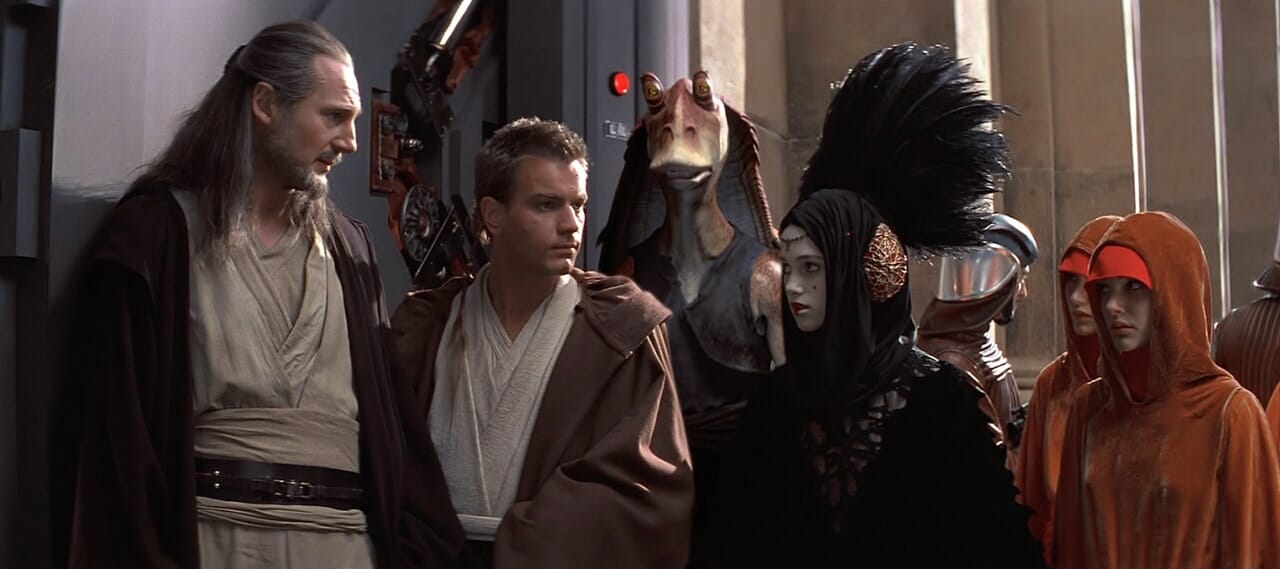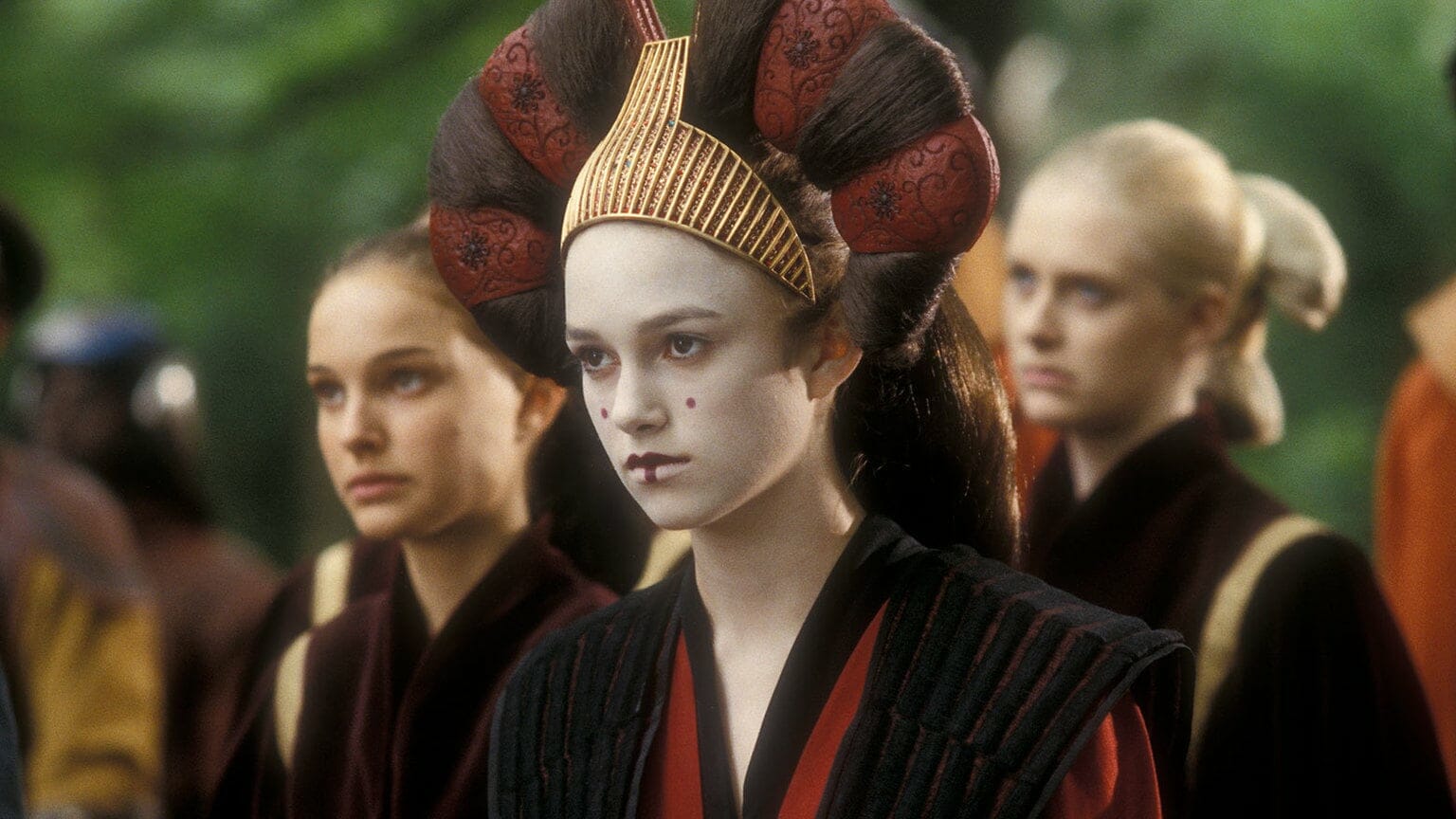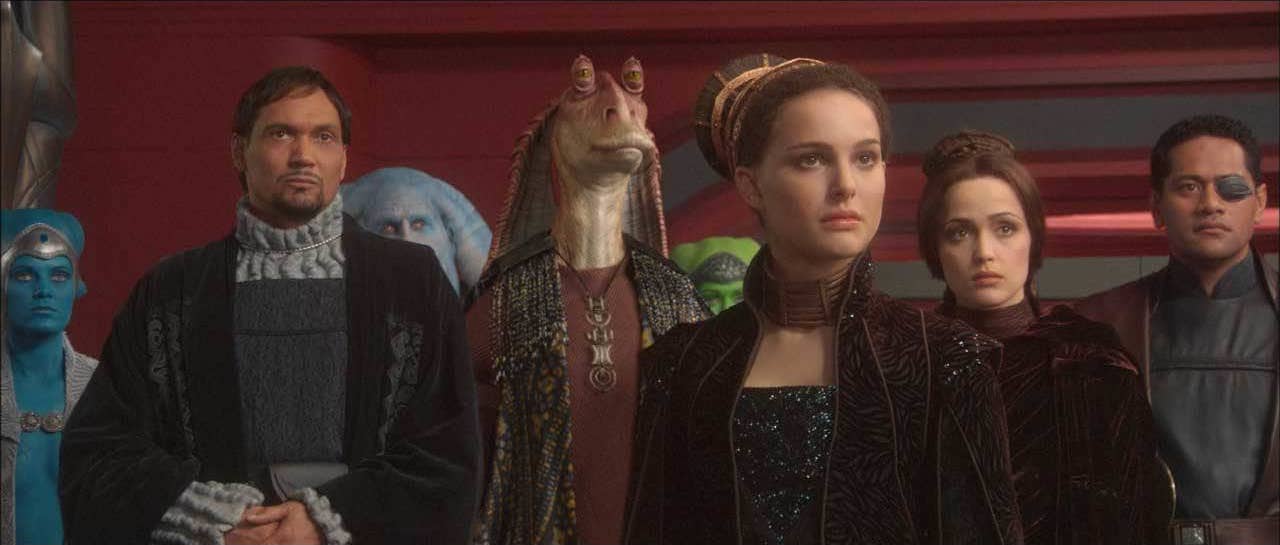Depending on the book or title, a new Star Wars tie-in can accomplish quite a bit. It can expand what we know about the Star Wars universe, give insight into characters we’ve known for years and reveal more about their motives, or provide more depth into the characters we didn’t get to spend enough time with. Queen’s Shadow does all three: It creates a rich and engaging world surrounding one of Star Wars’ more well-known characters—but one we seem to not know all that much about—and raises fascinating questions about the kinds of identities those in power and those around them put forward.

RELEASE DATE: 3/5/2019
AUTHOR: E.K. Johnston
PUBLISHER: Disney Lucasfilm Press
Padmé Amidala is appointed to the Galactic Senate as her reign as Queen of Naboo comes to an end. As Padmé quickly discovers, she has to play a much different political game to learn as her most trusted friend carries out a mission that’s deeply personal to Padmé.
In the Star Wars prequel trilogy, Padmé Amidala is a fascinating albeit frustrating look at a character who started off with promise but ended the trilogy with the short end of the stick thanks to poor writing. Like Leia Organa before her and Ahsoka Tano and Rey after her, Padmé would help create a new generation of Star Wars fans, many of them young girls and women.
But the insurmountable pressure of being the only lead female character in a film trilogy full of men also led to disappointment: Attack of the Clones made Padmé into one-half of an ill-fated and polarizing romance while Revenge of the Sith more or less turned Padmé into an incubator before she fulfilled her most important role: giving birth to Luke and Leia—who would one day help save the galaxy—before dying. And then the execution of her death was done so poorly that some fans have either condescendingly referred to Padmé as having died of a broken heart or tried to come up with complex theories to explain what happened. Star Wars: The Clone Wars gave her more depth between her career as a Republic senator and in her secret marriage with Anakin Skywalker, but she was rarely the focus of the story.

In part, it’s why Queen’s Shadow is such a breath of fresh air. Author E.K. Johnston gives us a Padmé story that’s deserving of her, expands upon throwaway details from the films and infuses them with new life, and seamlessly makes itself a part of the lore. But most importantly it zeroes in on the characters: not just Padmé, but many of the young women Padmé surrounds herself with. The role that Padmé’s handmaidens play is often misunderstood, although as one of Padmé’s former handmaidens puts it, they’re more than happy to let outsiders think what they will. They’re an integral part of Padmé, and Queen’s Shadow embraces that wholeheartedly.
Set firmly in the time period between The Phantom Menace and Attack of the Clones, Queen’s Shadow is a period of transition. After four years on the throne, Padmé has reached the end of her term and, despite a push from her supporters, she is ready to step down and let democracy take its course. After her successor is sworn in, the new Queen of Naboo asks Padmé to take up an open seat in the Galactic Senate, a task that Padmé is both very qualified for and extremely unprepared to take on. For one, the Galactic Senate has not forgotten the young queen who once took down a chancellor with only her words. That is something that both helps and hinders her first term, particularly as old politics reign supreme in Coruscant and the media puts her under constant scrutiny.
It’s easy to summarize what happens in Queen’s Shadow in a paragraph or two—politics and not much else. What the book does instead is take us into the world of Padmé and her handmaidens—particularly that of her most trusted handmaiden Sabé, who stepped in as the Queen of Naboo decoy for much of The Phantom Menace while Padmé moved around Tatooine and Naboo incognito.
Handmaidens are trained and handpicked to protect the Queen of Naboo. They give up their entire lives for an anonymous one as a queen’s protector; in the case of Padmé’s handmaidens, they even gave up their own names modeled them after hers. They share a closer and much more intimate relationship than they would with their family, friends, and sometimes even lovers. They’re able to share rare moments of pure joy and act their own age, but they’ll never be on equal footing. They love each other unconditionally, but if Padmé asked any handmaiden to give up their life for hers, they would without hesitation; Padmé is self-aware enough to know that.

It’s the relationship between Padmé and Sabé that lays at the heart of Queen’s Shadow. As the main decoy for Padmé Amidala, Padmé and Sabé often operated on a different level than even some of the other handmaidens. Now, they both have to figure out who they are without the other. The presence of the other is always felt, even when they haven’t spoken over long periods of time. Johnston places them on equal footing, or at least as much as they can be given the circumstance of their relationship.
As Queen’s Shadow illustrates, it’s not necessarily a bad thing, it’s just new. That’s particularly the case for Padmé, who became a queen at age 14, spent her formative teenage years ruling a planet, and has to transition into another role as a senator; she barely has time to figure out who Padmé is before she has to become Senator Amidala. Not even winning over fellow senators over or achieving a political victory can instantly solve the identity crisis that Padmé has, and it’s a constant struggle, something that Johnston doesn’t shy away from depicting. Although she plays a much different role, Sabé has a similar crisis of faith as she has to figure out just who she is as she travels to a familiar planet to carry out a mission for Padmé that often feels fruitless—and not just because we know how it ends. She has her own struggles, which are never treated as less than even if the stakes are much different than Padmé’s.
The book also never shies away from the scrutiny that public figures, especially women, face with every move they make, whether it’s in committees, at parties, or out in the Senate. At one point Padmé even speaks of her own identity to another woman in power in a rare moment of honesty as they compared how each planet handled their own affairs. Padmé had to carry “a certain suspension of self” while the other ruler required to give her “entire self.”

If you’ve seen The Clone Wars, Queen’s Shadow references more than a few of Padmé’s allies, colleagues, and thorns in her side; some are name-checked while others lurk in the shadows, none of whom are aware of the fates that await them in future stories. We’re several years off from the start of the Clone Wars, but some of the seeds of war lurk in the corners. And while the fashion of The Phantom Menace is on full display, Queen’s Shadow takes it several satisfying steps further.
Johnston relishes in describing the many, many outfits that Padmé wears for various occasions, but she highlights just how strategic it all is. Each stitch has meaning, dresses and suits are rendered fire and blastproof, and almost any accessory can be made into a weapon if need be. On top of that, just about anything that Padmé wears needs to be accessible enough that Padmé and her handmaidens can pull off their own tricks if they need to. Fashion is how they go to war, and they will take advantage of being underestimated every single time.
https://www.instagram.com/p/BtxKh4WnsQx/
Nearly 20 years after the theatrical release of The Phantom Menace, we’re finally getting a story worthy of Padmé and her handmaidens. While there’s a certain sadness that it took this long to get their story, we have it now and Queen’s Shadow has enough loose threads that we could someday find out more. It took decades for it to happen, but Padmé’s handmaidens are finally out of the shadows.
READ MORE:
- YouTuber who made popular Darth Vader fan film prevails in copyright fight
- Topher Grace made a beautiful ‘Star Wars’ trailer for all 10 movies
- This is the ‘Star Wars’ VR experience you’re looking for


